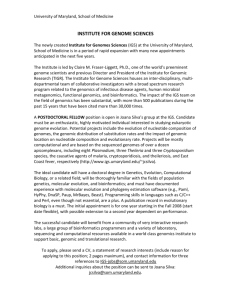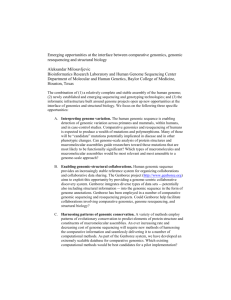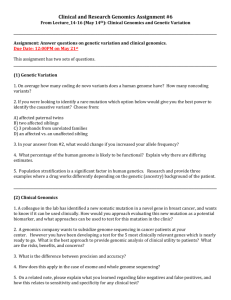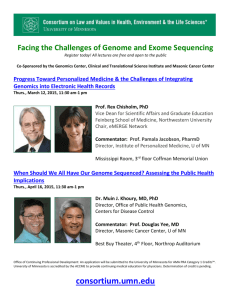Syllabus
advertisement
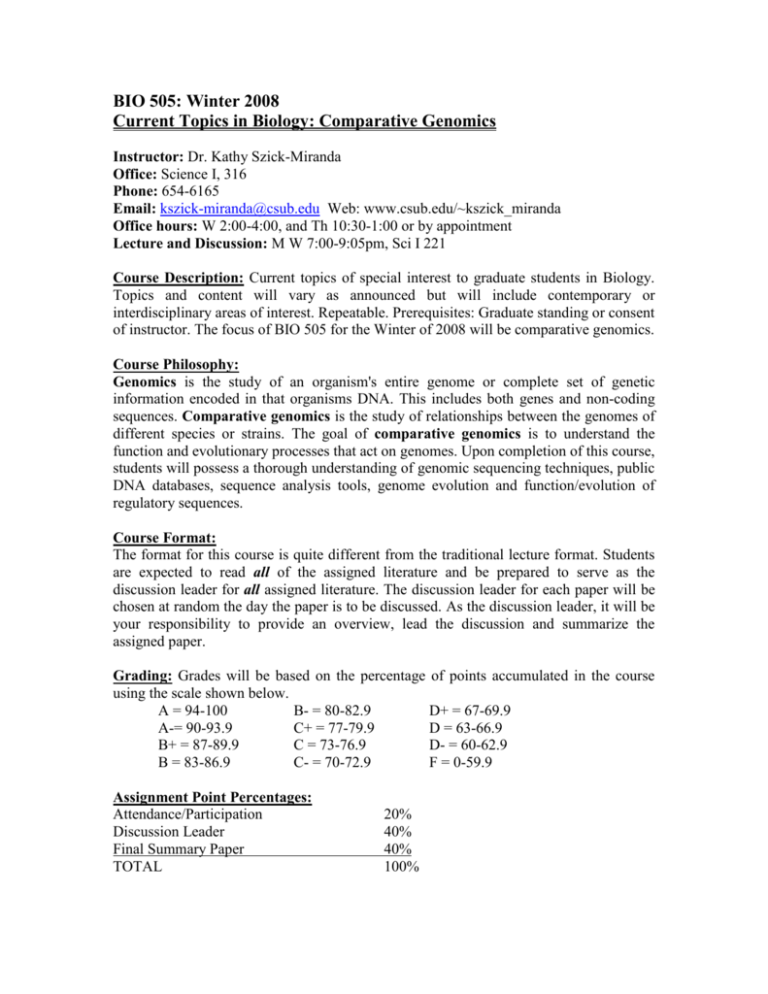
BIO 505: Winter 2008 Current Topics in Biology: Comparative Genomics Instructor: Dr. Kathy Szick-Miranda Office: Science I, 316 Phone: 654-6165 Email: kszick-miranda@csub.edu Web: www.csub.edu/~kszick_miranda Office hours: W 2:00-4:00, and Th 10:30-1:00 or by appointment Lecture and Discussion: M W 7:00-9:05pm, Sci I 221 Course Description: Current topics of special interest to graduate students in Biology. Topics and content will vary as announced but will include contemporary or interdisciplinary areas of interest. Repeatable. Prerequisites: Graduate standing or consent of instructor. The focus of BIO 505 for the Winter of 2008 will be comparative genomics. Course Philosophy: Genomics is the study of an organism's entire genome or complete set of genetic information encoded in that organisms DNA. This includes both genes and non-coding sequences. Comparative genomics is the study of relationships between the genomes of different species or strains. The goal of comparative genomics is to understand the function and evolutionary processes that act on genomes. Upon completion of this course, students will possess a thorough understanding of genomic sequencing techniques, public DNA databases, sequence analysis tools, genome evolution and function/evolution of regulatory sequences. Course Format: The format for this course is quite different from the traditional lecture format. Students are expected to read all of the assigned literature and be prepared to serve as the discussion leader for all assigned literature. The discussion leader for each paper will be chosen at random the day the paper is to be discussed. As the discussion leader, it will be your responsibility to provide an overview, lead the discussion and summarize the assigned paper. Grading: Grades will be based on the percentage of points accumulated in the course using the scale shown below. A = 94-100 B- = 80-82.9 D+ = 67-69.9 A-= 90-93.9 C+ = 77-79.9 D = 63-66.9 B+ = 87-89.9 C = 73-76.9 D- = 60-62.9 B = 83-86.9 C- = 70-72.9 F = 0-59.9 Assignment Point Percentages: Attendance/Participation Discussion Leader Final Summary Paper TOTAL 20% 40% 40% 100% Academic Policies: It is expected that your work is YOUR work. In the unexpected event of plagiarism and/or dishonesty during exams or for the research term-paper, the student will receive a zero on that activity and be referred to the campus administration for disciplinary action. Please refer to the campus 2007-2009 catalog page 81. Final Writing Assignment (Due Friday March 15th): Your final writing assignment is to prepare a clear, concise overview/summary of the field of comparative genomics. Your target audience is other biology graduate students who have not taken this specific version of BIO 505. You must include as many of the assigned articles as possible. In addition you must include 5 additional resources (other than those we covered in class). This writing assignment will serve as your final exam and is due at 5pm (preferable sooner!) on Friday March 15th. Course Schedule: January 2: Course introduction and distribution of reading material for lecture on January 7th. January 7: Bringing everyone up to speed. Lecture by Dr. Miranda January 9: Databases: Wheeler, D. L., et al. (2007) Database Resources of the National Center for Biotechnology Information. Nucleic Acids Research 35: 5-12. Benson, D. A., Karsch-Mizrachi, I., Lipman, D. J., Ostell, J. and Wheeler, D. L. (2007) GenBank. Nucleic Acids Research 35: 21-25. Crosby, M. A., Goodman, J. L., Strelets, V. B., Zhang, P., Gelbart, W. M., and The FlyBase Consortium. (2007) FlyBase: Genomes by the Dozen. Nucleic Acids Research 35: 486-491. Identifying Genes: Burge, C. B. and Karlin, S. (1998) Finding the Genes in Genomic DNA. Current Opinion in Structural Biology. 8:346-354. January 14: Comparative Genomics Tools: Loots, G. G. and Ovcharenko, I. (2005) Dcode.org Anthology of Comparative Genomics Tools. Nucleic Acids Research 33: 56-64. Brudno, M., Poliakov, A., Minovitsky, S., Ratnere, I., and Dubchak, I. (2007) Mulitple Whole Genome Alignments and Novel Biomedical Applications at the VISTA Portal. Nucleic Acids Research 35: 669-674. Liolios, K., Mavromatis, K., Tavernarakis, N., and Kyrpides, N. C. (2007) The Genomes On Line Database (GOLD) in 2007: Status of Genomic and Metagenomic Projects and their Associated metadata. Nucleic Acids Research Medigue, C., and Moszer, I. (2007) Annotation, Comparison and Databases for Hundreds of Bacterial Genomes. Research in Microbiology. 158:724-736. January 16: Comparisons (within species): Fleischmann, R. D., et al. (2002) Whole-Genome Comparison of Mycobacterium tuberculosis Clinical and Laboratory Strains. Journal of Bacteriology. 184(19), 5479-5490. Comparisons (minimal genome): Koonin, E. V. (2003) Comparative Genomics, Minimal Gene-Sets and the Last Universal Common Ancestor. Nature Reviews Microbiology 1: 127-136 January 21: HOLIDAY, Martin Luther King, Jr. Day January 23: Goffeau, A. et al. (1996) Life with 6000 genes. Science. 274:546-567. Rubin, G. M., et al. (2000) Comparative Genomics of the Eukaryotes. Science. 287:2204-2215. January 28: Human Genome: International Human Genome Sequencing Consortium (2001) Initial Sequencing and Analysis of the Human Genome. Nature. 409:860-921. January 30: Human Genome: Ventner, J. C., et al. (2001) The Sequence of the Human Genome. Science. 291: 1304-1351. February 4: Lindblad-Toh, K., et al. (2005) Genome Sequence, Comparative Analysis and Haplotype Structure of the Domestic Dog. Nature. 438:803-819. Putnam, N. H., et al. (2007) Sea Anemone Genome Reveals Ancestral Eumetazoan Gene Repertoire and Genomic Organization. Science 317: 86-94. February 6: Rhesus Macaque Genome Sequencing and Analysis Consortium (2007) Evolutionary and Biomedical Insights from the Rhesus Macaque Genome. Science. 316:222-234. Mikkelsen, T. S. et al. (2007) Genome of the Marsupial Monodelphis domestica Reveals Innovation in Non-coding Sequences. Nature. 447:167-178. February 11: Fitzpatrick, D. A., Logue, M.E., Stajich, J. E. and Butler, G. (2006) A Fungal Phylogeny Based on 42 Complete Genomes Derived from Supertress and Combined Gene Analysis. BMC Evolutionary Biology. 6:99-113. Galagan, J. E., Henn, M. R., Ma, L.-J., Cuomo, C. A. and Birren, B. (2007) Genomics of the Fungal Kingdom: Insights into Eukaryotic Biology. Genome Research. 15:1620-1631. February 13: Niimura, Y., and Nei, M. (2006) Evolutionary Dynamics of Olfactory and Other Chemosensory Receptor Genes in Vertebrates. J Hum Genet. 51:505-517. Vicario, S., Moriyama, E. N., and Powell, J. R. (2007) Codon Usage in Twelve Species of Drosophila. BMC Evolutionary Biology. 7:226-. February 18: Demuth, J. P., De Bie, T., Stajich, J. E., Cristianini, N., and Hahn, M.W. (2006) The Evolution of Mammalian Gene Families. PLoS One. 1: 1-12. Hahn, M. W., Han, M. V., and Han, S.-G. (2007) Gene Family Evolution across 12 Drosophila Genomes. PLoS Genetics. 3(11):2135-2146. February 20: Comparisons (non-coding DNA): Dermitzakis, E. T., et al. (2002) Numerous Potentially Functional but Non-genic Conserved Sequences on Human Chromosome 21. Nature. 420: 578-582. Cooper, G. M. and Sidow, A. (2003) Genomic Regulatory Regions: Insights from Comparative Sequence Analysis. Current Opinion in Genetics & Development. 13:604-610. February 25: Dermitzakis, E. T., Bergman, C. M., and Clark, A. G. (2003) Tracing the Evolutionary History of Drosophila Regulatory Regions with Models that Identify Transcription Factor Binding Sites. Mol. Biol. Evol. 20(5): 703-714. Kellis, M., Patterson, N., Endrizzi, M., Birren, B., and Lander, E. S. (2003) Sequencing and Comparison of Yeast Species to Identify Genes and Regulatory Elements. Nature. 423:241-254. February 27: Dermitzakis, E. T., Kirkness, E., Schearz, S., Birney, E., Reymond, A. and Antonarakis, S. (2004) Comparison of Human Chromosome 21 Conserved Nongenic Sequences (CNGs) with the Mouse and Dog Genomes Shoes that their Selective Constraint is Independent of their Genic Environment. Genome Research 14:852-859. Dermitzakis, E. T., Reymond, A., and Antonarakis, S. E. (2005) Conserved NonGenic Sequences – an Unexpected Feature of Mammalian Genomes. Nature Reviews Genetics. 6: 151-157. March 3: Bird, C. P., Stranger, B. E., and Dermitzakis, E. T. (2006) Functional Variation and Evolution of Non-coding DNA. Current Opinion in Genetics & Development. 16: 559-564. Yamamoto, Y. Y., Ichida, H., Abe, T., Suzuki, Y., Sugano, S. and Obokata, J. (2007) Differentiation of Core Promoter Architecture between Plants and Mammals Revealed by LDSS Analysis. Nucleic Acids Research. 35(18): 62196226. Stark, A., et al. (2007) Discovery of Functional Elements in 12 Drosophila Genomes using Evolutionary Signatures. Nature. 450:219-232. March 5: No class, work on papers. March 10: No class, work on papers.
